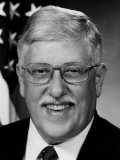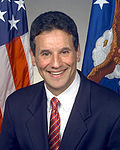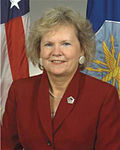Assistant Secretary of the Air Force (Acquisition, Technology and Logistics)
 From Wikipedia - Reading time: 7 min
From Wikipedia - Reading time: 7 min
| Assistant Secretary of the Air Force (Acquisitions, Technology, and Logistics) | |
|---|---|
 Seal of the assistant secretary of the air force for acquisitions, technology, and logistics | |
 Flag of an assistant secretary of the air force | |
since June 2, 2025 | |
| Department of the Air Force | |
| Style | The Honorable |
| Reports to | Secretary of the Air Force |
| Seat | The Pentagon, Arlington County, Virginia, United States |
| Nominator | The president with Senate advice and consent |
| Term length | No fixed term |
| Constituting instrument | 10 U.S.C. § 9016 |
| Formation | 1987 |
| Succession | 18th in SecDef succession by seniority of appointment |
| Deputy | Principal Deputy Assistant Secretary of the Air Force Acquisition, Technology & Logistics Principal Military Deputy for Acquisition, Technology & Logistics |
| Salary | Executive Schedule, Level IV |
| Website | ww3 |
Assistant Secretary of the Air Force (Acquisition, Technology, and Logistics) (SAF/AQ) is a civilian position in the Department of the Air Force that is appointed by the president of the United States and confirmed by the United States Senate. This position is established under Title 10 US Code Section 9016 and is one of five assistant secretary positions under the secretary of the air force. The assistant secretary reports to the secretary of the air force.
Under the law a principal military deputy serves with the assistant secretary of the air force for acquisition. The principal military deputy is required to be an active duty officer with a background in acquisition and program management. If the assistant secretary position is vacant the law permits the principal military deputy to serve up to a year as the acting assistant secretary. Of the five assistant secretary positions established by law, only the assistant secretary for acquisition is required to have a principal military deputy.[2]
Before Andrew Hunter, Darlene Costello served as acting assistant secretary for the second time. During the Obama and Trump administrations, Costello served as acting assistant secretary, from February 2016 to February 2018.[3] In 2018, Will Roper was confirmed to the role, serving from February 2018 to January 2021.[4] Despite Roper's requests to the Biden transition to be retained in the position in the new administration, his efforts went unheeded, and he resigned on January 20 as is custom.[5] Upon his departure, Darlene Costello again became acting assistant secretary until a new secretary is appointed. With 3 years in the role as of January 2022, Costello's service as SAF/AQ, spanning three presidencies and four secretaries of the air force, ranks among the longest in the history of the position, despite never being confirmed by the Senate.
On July 16, 2021, President Joe Biden nominated Andrew Hunter, a defense industry/acquisition researcher and former Pentagon official,[6] for the position, and Hunter was confirmed by the Senate on February 2, 2022.[7] Hunter was formerly a senior fellow at the Center for Strategic and International Studies' International Security Program and director of CSIS' Defense-Industrial Initiatives Group.[6]
Responsibilities
[edit]The assistant secretary of the air force for acquisition serves as the single service acquisition executive (SAE) and the senior procurement executive for the Department of the Air Force. They are responsible for acquisition and product support for all air force acquisition programs and manages the air force science and technology program.[8]
They provides direction, guidance and supervision of all matters pertaining to the formulation, review, approval and execution of acquisition plans, policies and programs. The assistant secretary oversees $40 billion annual investments that include major programs like the KC-46A Pegasus, F-35 Lighting II, B-21 Raider,[3] as well as capability areas such as information technology and command and control, intelligence, surveillance and reconnaissance (C4ISR) systems.
History
[edit]The assistant secretary of the air force for acquisition position was created in 1987 by National Security Decision Directive 219, following recommendations from President Reagan's Blue Ribbon Commission on Defense Management. The commission recommended the Department of Defense have clear lines of authority for acquisition management and outlined roles and responsibilities between the Office of the Secretary of Defense and the military departments. This move established the defense acquisition executive, the service acquisition executives for each military department, program executive officers who manage execution for a portfolio of programs.
Prior to 1987, similar duties and responsibilities now carried out by the assistant secretary for acquisition were performed by offices in the Headquarters Secretariat with the following names and dates:
- Assistant Secretary for Material - May 1951 to February 1964
- Special Assistant for Research and Development - September 1950-February 1955
- Assistant Secretary for Research and Development - March 1955 to May 1977
- Assistant Secretary for Research, Development and Logistics - May 1977-April 1987[9]
Assistant secretaries of the air force (acquisition, technology, and logistics)
[edit]References
[edit]- ^ https://www.af.mil/About-Us/Biographies/Display/Article/686177/william-d-bailey/
- ^ 10 U.S.C. § 9016(b)(4)(b).
- ^ a b "Darlene Costello Biography". www.af.mil. Retrieved 2017-04-21.
- ^ "Dr. Will Roper Biography". U.S. Air Force. Retrieved 2018-03-24.
- ^ Weisgerber, Marcus (January 5, 2021). "Roper Makes His Pitch To Biden Team: 'I Want to Be Part of the China fight'". Defense One. Archived from the original on 2021-01-14. Retrieved 2021-06-09.
- ^ a b "President Biden Announces Seven Key Nominations" (Press release). Washington, D.C.: White House. July 16, 2021. Retrieved July 17, 2021.
- ^ Sheehey, Maeve (July 16, 2021). "Former Sen. Tom Udall is Biden's pick as ambassador to New Zealand and Samoa". POLITICO. Retrieved July 17, 2021.
- ^ "Headquarters Air Force Mission Directive 1-10" (PDF). www.e-publishing.af.mil/. Retrieved 2018-03-23.
- ^ a b Benson, Lawrence (1997). Acquisition Management in the United States Air Force and its Predecessors. US Government Printing Office. p. 55.
- ^ services, united states. congress. senate. committee on armed. "Image 25 of Nominations of Hans M. Mark, Antonia H. Chayes, Robert Jay Hermann, and John Howard Moxley III : hearing before the Committee on Armed Services, United States Senate, Ninety-sixth Congress, first session ... July 13, 1979". The Library of Congress. Retrieved 2017-04-21.
- ^ Directors at the National Reconnaissance Office at Fifty Years (PDF). Center for the Study of National Reconnaissance. 2011. p. 25. Archived from the original (PDF) on 2016-12-21. Retrieved 2017-04-21.
- ^ Nomination of Thomas Edward Cooper To Be an Assistant Secretary of the Air Force, Dec. 15, 1982. Note: Keel held the title "Assistant Secretary of the Air Force (Research, Development, and Logistics)"
- ^ "PN528 - Nomination of Alton Gold Keel Jr. for Department of Defense, 97th Congress (1981-1982)". www.congress.gov. 1981-07-30. Retrieved 2017-04-21.
- ^ Nomination of Thomas Edward Cooper To Be an Assistant Secretary of the Air Force, Dec. 15, 1982. Cooper was initially appointed "Assistant Secretary of the Air Force (Research, Development, and Logistics)". The title changed in the course of Cooper's tenure in office.
- ^ George Bush: Continuation of John J. Welch, Jr., as an Assistant Secretary of the Air Force, Aug. 9, 1989
- ^ Wincup bio
- ^ "Clinton nomination". Archived from the original on 2011-07-21. Retrieved 2011-02-26.
- ^ "PN695 - Nomination of Arthur L. Money for Department of Defense, 104th Congress (1995-1996)". www.congress.gov. 1996-01-26. Retrieved 2017-04-21.
- ^ "Honorable Arthur L. Money, Senior Fellow". www.potomacinstitute.org. Retrieved 2017-04-21.
- ^ "Air Force Biography". Archived from the original on April 1, 2001. Retrieved 2017-05-12.
{{cite web}}: CS1 maint: bot: original URL status unknown (link) - ^ "PN117 — Lawrence J. Delaney — Department of Defense". congress.gov.
- ^ Archived biography
- ^ "PN821 — Marvin R. Sambur — Department of Defense". congress.gov.
- ^ Payton Bio from Air Force[usurped]
- ^ "PN1473 — Sue C. Payton — Department of Defense". congress.gov.
- ^ "Van Buren bio". Archived from the original on February 2, 2011.
- ^ "LaPlante bio". Archived from the original on May 2, 2014.
- ^ "Air Force acquisition lead moves to MITRE".
- ^ https://www.linkedin.com/posts/williamroper_after-36-years-of-extraordinary-public-service-activity-7334163621570109441-gS-l
- John J. Martin, Robert J. Hermann, Alton G. Keel, Martin F. Chen and Thomas E. Cooper all held the title "Assistant Secretary (Research, Development, and Logistics)." Daniel Rak was the first Acting Assistant Secretary (Acquisition).
 KSF
KSF













